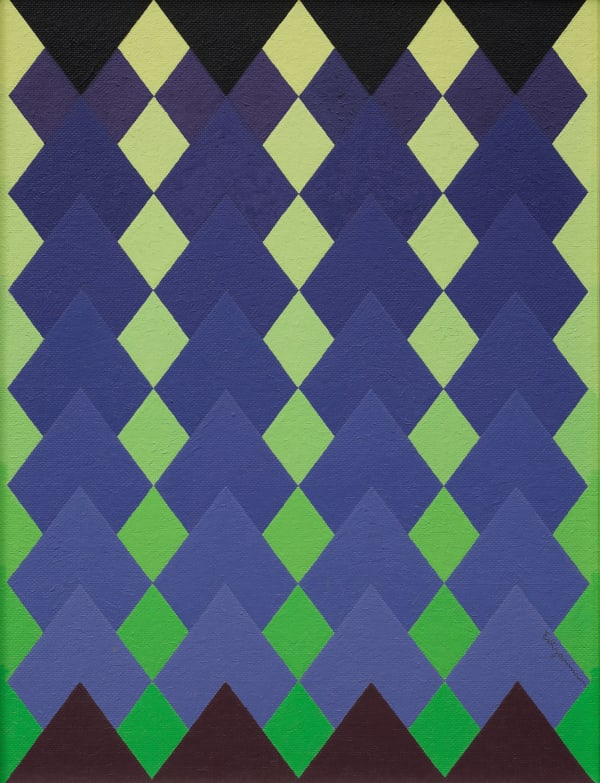Ed Garman US, 1914-2004
"The Great Depression was in full swing. Contemplating going into the arts as a lifetime profession was the ultimate in an irrational hope and a guarantee of economic and social suicide. Then, of all things, to choose an area of interest inpainting that was so coldly received as was abstract painting was yet another step into the twilight zone."
- Ed Garman
Ed Garman was born in Bridgeport, Connecticut, and raised in the Lehigh Valley of Pennsylvania. In 1933 Garman moved to the Southwest to study stage design at the University of New Mexico. While working for the university theater, he discovered the work of turn-of-century European designers Adolphe Appia and Edward Gordon Craig, whose concepts for simple, yet dramatic stage designs interested Garman in the possibilities of structural form. Later, working for a WPA project, Garman sorted pottery shards at an archaeological dig and became fascinated with the geometric patterns and arrangements of Native American designs. These experiences caused him to develop a growing enthusiasm for abstraction, which further grew after seeing a Vincent van Gogh retrospective and the work of Wassily Kandinsky at the Art Institute of Chicago in 1935.
Garman soon thereafter completed his first group of semi-abstract paintings. Continuing to search for inspiration, he went to Mexico for six months in 1937 to study murals by Diego Rivera and José Clemente Orozco. While Garman was interested in the abstract style of the murals, he was not impressed by the nationalistic agenda of the Mexican muralists, preferring art be separate from politics. The following year Garman married Coreva Hanford, a philosophy student who introduced him to the concept of Platonic philosophy, which also had an influence on Garman’s art. In 1940 he visited New York where he was further inspired by the works of Kandinsky and Rudolf Bauer at the Museum of Non-Objective Painting. Combining his various aesthetic and philosophical influences Garman solidified his signature art style during the late 1930s and early 1940s. His work explored the relationship between line, form, and shape while utilizing flat, unmodulated color to create reductive abstractions free from political and moral commentary.
Garman was introduced to the Transcendental Painting Group in 1941 through artist William Lumpkins, who Garman had met while working on a National Youth Administration Project in New Mexico. Garman developed a strong friendship with fellow Transcendentalist Raymond Jonson. Jonson became his mentor, encouraging the younger artist to continue his ideas while exploring the spiritual aspect of his painting, a key part of the Transcendentalist’s tenets. Garman want on to write a biography on Jonson and published The Art of Raymond Jonson, Painter in 1976.
Garman, like many of the Transcendentalists, was forced to put art aside due to World War II. In late 1943 he was drafted into the U.S. Navy and stationed in California. Despite having little time to paint, he made occasional trips to the San Francisco Museum of Art and continued to develop his ideas on geometric abstraction.
By the mid 1940s, Garman had developed a theory he called “dynamic painting,” in which he attempted to evoke varied “empathetic responses” from the viewer by exploring the concept of movement and stillness in his works. Following the war Garman moved permanently to California, where he continued painting until his death in 2004. His work is included in the collections of the Metropolitan Museum of Art, The Solomon R. Guggenheim Museum, The Smithsonian American Art Museum, the Los Angeles County Museum of Art, and the Museum of Contemporary Art San Diego.



